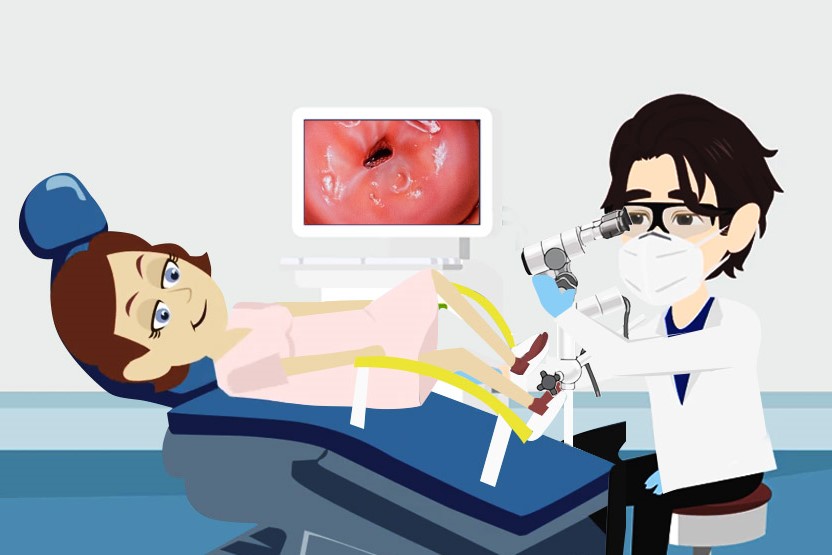
Colposcopy: how to prepare, how it is performed, when it is important
Colposcopy is an examination that allows a magnified view of the cervix, the outermost part of the cervix. It is very popular as it is an inexpensive, painless, non-invasive and repeatable examination
The enlarged view is enabled by an instrument called a ‘colposcope’ that enlarges the tissue from 2 to 60 times, allowing the doctor to detect abnormalities, any lesions, alterations or neoplasms that might escape the naked eye.
Why is a colposcopy necessary?
Colposcopy is used primarily to investigate any abnormalities of cervical cells revealed by the Pap test.
It is also used to investigate the cause of bleeding from the vagina, especially after sexual intercourse, or pelvic pain.
During the examination, the patient must assume the gynaecological position (exactly as for the Pap test) and the vagina is dilated with a special instrument, called a speculum.
In colposcopy, is anything inserted into the vagina?
Simple colposcopy is performed using a colposcope, an instrument that is NOT inserted inside the vagina, but allows the affected area to be examined as if it were a kind of binoculars.
The situation is different if samples have to be taken from the affected tissue.
How is a colposcopy performed?
The patient gets into the gynaecological position (lying on her back with her legs spread apart and resting on the couch’s stirrups) and the doctor simply observes the cervix through the colposcope.
The doctor may apply some liquids (e.g. acetic acid or iodine solutions) to the cervix, which serve to better visualise any cellular abnormalities.
It is therefore a good idea to report the presence of allergies to these substances.
During the examination, small tissue samples may sometimes be taken (biopsy) or abnormal parts may be removed directly (electroexcision, LLETZ).
Colposcopy: how to prepare for the examination?
Unless otherwise indicated by the doctor, no special preparation is required to perform a colposcopy.
Sometimes the doctor may consider it advisable to remove intrauterine contraceptives (IUDs or IUDs) during the examination, in which case it is advisable to abstain from sexual intercourse or to use a condom for at least five days prior to the examination.
In the 24 hours prior to the examination, however, sexual intercourse should be avoided altogether, as should the use of tampons, pessaries, creams or vaginal irrigation.
There is also no need to be accompanied to the examination because drugs that contraindicate driving vehicles are not usually used.
Can I have a colposcopy during my period?
The examination cannot be performed during the menstrual cycle: it should be postponed in this case.
In addition, the examination should be avoided in the presence of severe inflammation or dystrophy of the vaginal mucosa, which are typical menopausal conditions.
Pregnant women can undergo the test instead.
Is colposcopy painful or uncomfortable?
Colposcopy is not painful, but you may feel a tingling sensation or a slight burning sensation when the acetic acid or iodine solutions are applied.
Or a small stinging may be felt if a biopsy is performed.
Is colposcopy a dangerous examination?
The examination is not dangerous and possible complications are very rare and usually related to an allergic reaction to the materials used in the test.
I have some bleeding after the examination: is this normal?
To a certain extent, some minor bleeding is possible after colposcopy, however, if the bleeding is copious and does not seem to subside after a long time and/or is associated with high fever with chills or severe abdominal pain, it is best to seek medical advice immediately.
Read Also:
Emergency Live Even More…Live: Download The New Free App Of Your Newspaper For IOS And Android
Abnormal Uterine Bleeding: Causes And Tests To Be Performed
How Does Cystitis Manifest Itself?
Cystitis, Antibiotics Are Not Always Necessary: We Discover Non-Antibiotic Prophylaxis
Vulvodynia: What Are The Symptoms And How To Treat It
What Is Vulvodynia? Symptoms, Diagnosis And Treatment: Talk To The Expert
Accumulation Of Fluid In The Peritoneal Cavity: Possible Causes And Symptoms Of Ascites
What’s Causing Your Abdominal Pain And How To Treat It
Pelvic Varicocele: What It Is And How To Recognise The Symptoms
Can Endometriosis Cause Infertility?
Transvaginal Ultrasound: How It Works And Why It Is Important
Candida Albicans And Other Forms Of Vaginitis: Symptoms, Causes And Treatment
What Is Vulvovaginitis? Symptoms, Diagnosis And Treatment
Vaginal Infections: What Are The Symptoms?
Chlamydia: What Are The Symptoms And How To Treat It
Chlamydia, Symptoms And Prevention Of A Silent And Dangerous Infection
Spotting, Or Atypical Female Bleeding: What It Is And The Diagnostic Pathway
What Are The Symptoms Of Urethritis And How Is It Treated?


